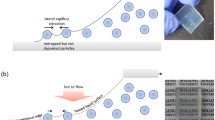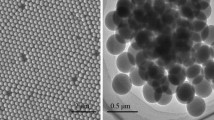Abstract
The increased use of viscous electrolytes in dye-sensitized solar cells (DSSCs) has revitalized the interest in three-dimensionally ordered macroporous (3DOM) structures as potential electrodes. The simplest approach to a 3DOM structure, such as inverse opals, is colloidal assembly followed by precursor infiltration and calcination. However, current assembly methods are often optimized for very narrow particle size ranges due to the colloidal forces specific to the method used. Using five particle sizes, ranging from 0.5 to 10 μm, we have studied the particle-size dependence of six commonly used colloidal assembly methods and its effect on the resulting inverse opal structure using scanning electron microscopy and Fast Fourier Transforms. Our results indicate a clear correlation between particle size and colloidal assembly method. The information provided by our study will enable systematic studies on inverse opal TiO2 electrodes with various pore sizes, in which the influence of the inverse opal preparation methods used is minimized.






Similar content being viewed by others
References
D.L. Douglas and J.R. Birk: Secondary batteries for electrical energy storage. Annu. Rev. Energy 5(1), 61–88 (1980).
S. Srinivasan, R. Mosdale, P. Stevens, and C. Yang: Fuel cells: Reaching the era of clean and efficient power generation in the twenty-first century. Annu. Rev. Energy Env. 24(1), 281–328 (1999).
M. Grätzel: Dye-sensitized solar cells. J. Photochem. Photobiol., C 4, 145 (2003).
B. O’Regan and M. Grätzel: A low-cost, high-efficiency solar cell based on dye-sensitized colloidal TiO2 films. Nature 353, 737 (1991).
Y.M. Cao, Y. Bai, Q.J. Yu, Y.M. Cheng, S. Liu, D. Shi, F.F. Gao, and P. Wang: Dye-sensitized solar cells with a high absorptivity ruthenium sensitizer featuring a 2-(Hexylthio) thiophene conjugated bipyridine. J. Phys. Chem. C 113, 6290 (2009).
J.H. Yum, E. Baranoff, S. Wenger, M.K. Nazeeruddin, and M. Grätzel: Panchromatic engineering for dye-sensitized solar cells. Energy Environ. Sci. 4, 842 (2011).
J. Bisquert and V.S. Vikhrenko: Interpretation of the time constants measured by kinetic techniques in nanostructured semiconductor electrodes and dye-sensitized solar cells. J. Phys. Chem. B 108(7), 2313–2322 (2004).
E. Galoppini, J. Rochford, H. Chen, G. Saraf, Y. Lu, A. Hagfeldt, and G. Boschloo: Fast electron transport in metal organic vapor deposition grown dye-sensitized ZnO nanorod solar cells. J. Phys. Chem. B 110(33), 16159–16161 (2006).
S.M. Feldt, G. Wang, G. Boschloo, and A. Hagfeldt: Effects of driving forces for recombination and regeneration on the photovoltaic performance of dye-sensitized solar cells using cobalt polypyridine redox couple. J. Phys. Chem. C 115(43), 21500 (2011).
M.K. Wang, J.Y. Liu, N.L. Cevey-Ha, S.J. Moon, P. Liska, R. Humphrey-Baker, J.E. Moser, C. Grätzel, P. Wang, S.M. Zakeeruddin, and M. Grätzel: High efficiency solid-state sensitized heterojunction photovoltaic device. Nano Today 5, 169 (2010).
CRC Handbook of Chemistry and Physics, D.R. Lide, ed; CRC Press LLC: New York, 1998.
Ultrapure(R) Ethylene Carbonate. Huntsman Tech. Bull. (2007).
A. Mihi, M.E. Calvo, J.A. Anta, and H. Miguez: Spectral response of opal-based dye-sensitized solar cells. J. Phys. Chem. C 112(1), 13–17 (2007).
A. Stein: Sphere templating methods for periodic porous solids. Microporous Mesoporous Mater. 45, 227–239 (2001).
O.D. Velev and E.W. Kaler: Structured porous materials via colloidal crystal templating: From inorganic oxides to metals. Adv. Mater. 12(7), 531–534 (2000).
Y. Xia, B. Gates, Y. Yin, and Y. Lu: Monodispersed colloidal spheres: Old materials with new applications. Adv. Mater. 12(10), 693–713 (2000).
V.L. Colvin: From opals to optics: Colloidal photonic crystals. MRS Bull. 26(8), 637–641 (2001).
F. Meseguer, A. Blanco, H. Miguez, F. Garcia-Santamaria, M. Ibisate, and C. Lopez: Synthesis of inverse opals. Colloids Surf., A 202, 281–290 (2002).
S.I. Bozhko, A.N. Chaika, G.A. Emelchenko, V.M. Masalov, A.M. Ionov, A.N. Gruzintsev, G.M. Mikhailov, and B.K. Medvedev: Mono- and multilayered opalline superlattices: Application to nanotechnology of 2D ordered array of nanoobjects and 3D metalattices. Appl. Surf. Sci. 234(1–4), 93–101 (2004).
M.C. Goncalves, J. Bras, and R.M. Almeida: Process optimization of sol-gel derived colloidal photonic crystals. J. Sol-Gel Sci. Technol. 42, 135–143 (2007).
G.I.N. Waterhouse and M.R. Waterland: Opal and inverse opal photonic crystals: Fabrication and characterization. Polyhedron 26, 356–368 (2007).
R.L. Whitmore: The sedimentation of suspensions of spheres. Br. J. Appl. Phys. 6, 239–245 (1955).
A.D. Maude and R.L. Whitmore: A generalized theory of sedimentation. Br. J. Appl. Phys. 9, 477–482 (1958).
R. Mayoral, J. Requena, J.S. Moya, C. López, A. Cintas, H. Miguez, F. Meseguer, L. Vázquez, M. Holgado, and A. Blanco: 3D long-range ordering in SiO2 submicrometer sphere sintered superstructure. Adv. Mater. 9(3), 257–260 (1997).
Y. Liu, S. Wang, J.W. Lee, and N.A. Kotov: A floating self-assembly route to colloidal crystal templates for 3D cell scaffolds. Chem. Mater. 17(20), 4918–4924 (2005).
A.L. Rogach, N.A. Kotov, D.S. Koktysh, J.W. Ostrander, and G.A. Ragoisha: Electrophoretic deposition of latex-based 3D colloidal photonic crystals: A technique for rapid production of high quality opals. Chem. Mater. 12(9), 2721–2726 (2000).
B.G. Prevo and O.D. Velev: Controlled, rapid deposition of structured coating from micro- and nanoparticle suspensions. Langmuir 20, 2099–2107 (2004).
P. Jiang, J.F. Bertone, K.S. Hwang, and V.L. Colvin: Single-crystal colloidal multilayers of controlled thickness. Chem. Mater. 11(8), 2132–2140 (1999).
S. Wong, V. Kitaev, and G. Ozin: Colloidal crystal films: Advances in universality and perfection. J. Am. Chem. Soc. 125, 15589–15598 (2003).
R.G. Shimmin, A.J. DiMauro, and P.V. Braun: Slow vertical deposition of colloidal crystals: A Langmuir-Blodgett process? Langmuir 22, 6507–6513 (2006).
B. Hatton, L. Mishchenko, S. Davis, K.H. Sandhage, and J. Aizenberg: Assembly of large-area, highly ordered, crack-free inverse opal films. PNAS 107(23), 10354–10359 (2010).
P. Kumnorkaew and J.F. Gilchrist: Effect of nanoparticle concentration on the convective deposition of binary suspensions. Langmuir 25(11), 6070–6075 (2009).
C.B. Murray, C.R. Kagan, and M.G. Bawendi: Synthesis and characterization of monodisperse nanocrystals and close-packed nanocrystal assemblies. Annu. Rev. Mater. Res. 30, (2000). pp. 545–610.
E. Scolan and C. Sanchez: Synthesis and characterization of surface-protected nanocrystalline titania particles. Chem. Mater. 10, 3217–3223 (1998).
W. Liu, B. Zou, J. Zhao, and H. Cui: Optimizing sol-gel infiltration for the fabrication of high-quality titania inverse opal and its photocatalytic activity. Thin Solid Films 518(17), 4923–4927 (2010).
A. Imhof and D.J. Pine: Ordered macroporous materials by emulsion templating. Nature 389, 948 (1997).
B.T. Holland, C.F. Blanford, and A. Stein: Synthesis of macroporous minerals with highly ordered three-dimensional arrays of spheroidal voids. Science 281, 538 (1998).
J.E.G.J. Wijnhoven and W.L. Vos: Preparation of photonic crystals made of air spheres in titania. Science 281, 802 (1998).
C.F. Blanford, C.B. Carter, and A. Stein: A method for determining void arrangements in inverse opals. J. Microsc. 216(3), 263–287 (2004).
E. Palacios-Lidon, B.H. Juárez, E. Castillo-Martinez, and C. Lópex: Optical and morphological study of disorder in opals. J. Appl. Phys. 97, 063502 (2005).
A. Sinitskii, V. Abramova, T. Laptinskaya, and Y.D. Tretyakov: Domain mapping of inverse photonic crystals by laser diffraction. Phys. Lett. A 366, 516–522 (2007).
O. Vickreva, O. Kalinina, and E. Kumacheva: Colloid crystal growth under oscillatory shear. Adv. Mater. 12(2), 110–112 (2000).
Acknowledgments
This research was supported by funding from PSC-CUNY Awards (Nos. 69038-0038, -0039, and -0040) and an Electricity Storage Research Seed Grant from the CUNY Energy Institute. SM acknowledges NSF IGERT (No. 0221589) and CENSES (NSF No. 0833180) for graduate fellowships. Prof. Raymond Tu is acknowledged for his helpful comments on an earlier version of this manuscript.
Author information
Authors and Affiliations
Corresponding author
Rights and permissions
About this article
Cite this article
Mathew, S.S., Ma, S. & Kretzschmar, I. Three-dimensionally ordered macroporous TiO2 electrodes: Fabrication of inverse TiO2 opals for pore-size-dependent characterization. Journal of Materials Research 28, 369–377 (2013). https://doi.org/10.1557/jmr.2012.311
Received:
Accepted:
Published:
Issue Date:
DOI: https://doi.org/10.1557/jmr.2012.311




